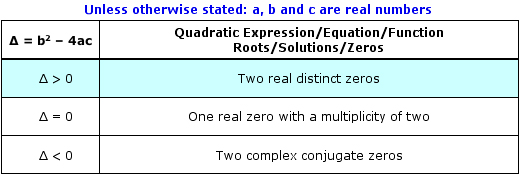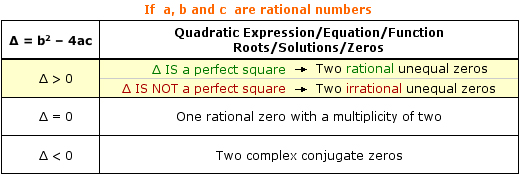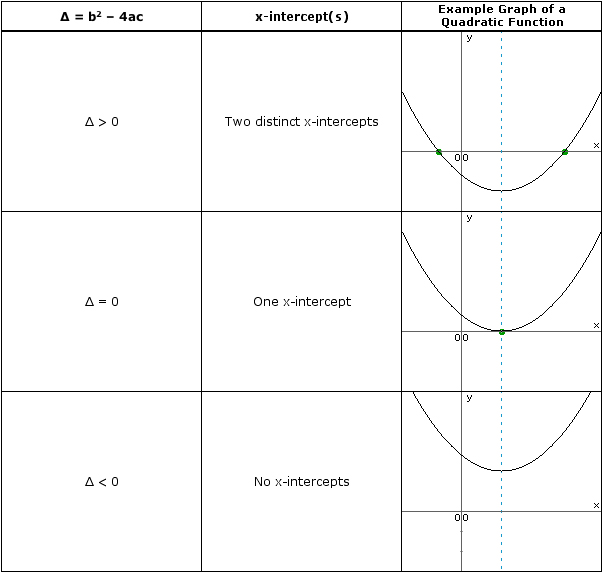Discriminant
Definition
The discriminant is the name given to the radicand of the quadratic formula.
The symbol for the discriminant is "Δ". Δ = b2 - 4ac.
Given a quadratic equation of the form ax2 + bx + c = 0, the solutions to the quadratic equation are given by the quadratic formula.
The Role of the Discriminant
Graphical Interpretation
Example One
State the type of solutions given the quadratic equation: x2 - 2x - 17 = 0 ( a = 1, b = -2, c = -17)
Since a, b and c are rational and the discriminant is NOT a perfect square, the solutions are irrational.
The "best" method for solving this quadratic equation is either by the quadratic formula, or by completing the square.
Click here to see the graph of the corresponding quadratic function y = x2 - 2x - 17. Note that since Δ > 0, there are two distinct x-intercepts.
Example Two
State the type of solutions given the quadratic equation: -4x2 + 6x + 4 = 0
Before the value of the discriminant is calculated, the equation can be reduced to a simpler form by dividing both sides of the equation by -2. The result is the quadratic equation: 2x2 - 3x - 2 = 0 ( a = 2, b = -3, c = -2).
Since a, b and c are rational and the discriminant IS a perfect square, the solutions are rational.
The "best" method for solving this quadratic equation is by factoring.
Click here to see the graph of the corresponding quadratic function y = -4x2 + 6x + 4. Note that since Δ > 0, there are two distinct x-intercepts.
Example Three
State the type of solutions given the quadratic equation: 4x2 - 12x + 9 = 0 ( a = 4, b = -12, c = 9)
Since a, b and c are rational and the discriminant is zero, there is one rational solution with a multiplicity of two.
The "best" method for solving this quadratic equation is by factoring.
Click here to see the graph of the corresponding quadratic function y = 4x2 - 12x + 9. Note that since Δ = 0, there is one x-intercept.
Example Four
State the type of solutions given the quadratic equation: x2 - 4x + 7 = 0 ( a = 1, b = -4, c = 7)
Since a, b and c are rational and the discriminant is less than zero, there are two complex conjugate solutions.
The "best" method for solving this quadratic equation is either by the quadratic formula, or by completing the square..
Click here to see the graph of the corresponding quadratic function y = 4x2 - 12x + 9. Note that since Δ = 0, there is one x-intercept.









